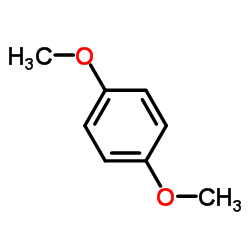1,4-Dimethoxybenzene

1,4-Dimethoxybenzene structure
|
Common Name | 1,4-Dimethoxybenzene | ||
|---|---|---|---|---|
| CAS Number | 150-78-7 | Molecular Weight | 138.164 | |
| Density | 1.0±0.1 g/cm3 | Boiling Point | 212.6±0.0 °C at 760 mmHg | |
| Molecular Formula | C8H10O2 | Melting Point | 54-56 °C(lit.) | |
| MSDS | Chinese USA | Flash Point | 73.5±19.4 °C | |
| Symbol |

GHS07 |
Signal Word | Warning | |
|
Heterolysis of Dihydrogen by Silver Alkoxides and Fluorides.
Chemistry 21 , 10160-9, (2015) Alkoxide-bridged disilver cations react with dihydrogen to form hydride-bridged cations, releasing free alcohol. Hydrogenolysis of neutral silver fluorides affords hydride-bridged disilver cations as their bifluoride salts. These reactions proceed most effici... |
|
|
Kinetic and docking studies of phenol-based inhibitors of carbonic anhydrase isoforms I, II, IX and XII evidence a new binding mode within the enzyme active site.
Bioorg. Med. Chem. 19 , 1381-9, (2011) Carbonic anhydrases (CAs, EC 4.2.1.1) are inhibited by sulfonamides, inorganic anions, phenols, coumarins (acting as prodrugs) and polyamines. A novel class of CA inhibitors (CAIs), interacting with the CA isozymes I, II (cytosolic) and IX, XII (transmembrane... |
|
|
Ozonolysis of lignin models in aqueous solution: anisole, 1,2-dimethoxybenzene, 1,4-dimethoxybenzene, and 1,3,5-trimethoxybenzene.
Environ. Sci. Technol. 43(16) , 6275-82, (2009) The lignin models anisole, 1,2-dimethoxybenzene, 1,4-dimethoxybenzene, and 1,3,5-trimethoxybenzene were reacted with ozone in aqueous solution, and major products were identified and quantified with respect to ozone consumption when reference material was ava... |
|
|
Decrease in glucose oxidation in isolated brown fat cells from rats due to tropolone and dimethoxybenzene.
Gen. Pharmacol. 12(1) , 47-50, (1981) 1. 1. Glucose conversion to carbon dioxide in control and insulin treated brown fat cells is reduced in the presence of tropolone and dimethoxybenzene. 2. 2. The effects of ortho-, meta- and para-dimethoxybenzene are similar to each other; all are more potent... |
|
|
Oxidation of dimethoxylated aromatic compounds by lignin peroxidase from Phanerochaete chrysosporium.
Eur. J. Biochem. 237(1) , 45-57, (1996) The stabilities of the cation radicals of veratryl alcohol, 3,4-dimethoxytoluene and 1,4-dimethoxybenzene were compared by monitoring the formation of dimeric products during the oxidation of these substrates by lignin peroxidase (LiP). LiP oxidized veratryl ... |
|
|
Aerobic oxidative coupling of arenes and olefins through a biomimetic approach.
Chemistry 19(13) , 4140-5, (2013) Arenes and electron-deficient olefins can be oxidatively coupled through a biomimetic Pd(OAc)2-catalyzed transformation. C-H activation of the arene partner is effected under reaction conditions of low catalyst loading, normal oxygen pressure, and using p-ben... |
|
|
Mechanism of antitumoral activity of catechols in culture.
Biochem. Pharmacol. 36(4) , 417-25, (1987) Cell lines Raji and K 562, lacking tyrosinase, and two melanotic human melanoma cell lines (IRE 1 and IRE 2), were exposed to concentrations from 5 X 10(-3) M to 10(-5) M of different phenols which are substrates of tyrosinase, i.e. l-dopa, dopamine, hydroqui... |
|
|
Analysis of biogenic volatile organic compounds in zucchini flowers: identification of scent sources.
J. Chem. Ecol. 31(10) , 2309-22, (2005) An analytical method has been applied to determine volatile organic compounds in zucchini flowers. In a first step, the analytical method was applied to characterize the main scents emitted by whole male and female living flowers of three main commercial cult... |
|
|
Nitration of veratryl alcohol by lignin peroxidase and tetranitromethane.
Arch. Biochem. Biophys. 352(1) , 121-9, (1998) Lignin peroxidase (LiP), from Phanerochaete chrysosporium, in the presence of H2O2 and tetranitromethane (TNM), oxidizes veratryl (3,4-dimethoxybenzyl) alcohol (VA) (I) to veratraldehyde (IV), 4,5-dimethoxy-2-nitrobenzyl alcohol (V), and 3,4-dimethoxy-nitrobe... |
|
|
Selective monoiodination of aromatic compounds with electrochemically generated I+ using micromixing.
Chem. Commun. (Camb.) (36) , 3794-6, (2006) Selective monoiodination of aromatic compounds such as dimethoxybenzene has been successfully achieved with I+, which is generated by anodic oxidation of I2 in acetonitrile, using micromixing. |